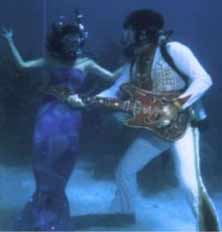
Anything goes at No Name Keys
Even in a chain of islands whose residents have been known for their odd manners and general aversion to conformity, No Name Key has always stood out. Or rather it has tried not stand out. The residents of the island prefer anonymity to celebrity, and want to stay that way. But huge interest in properties on the island and its bigger neighbor, Big Pine Key, is giving them a headache.
No Name Key has lovely waterfront homes but no electricity. Residents have fought for years to keep their refuge off the grid. Now the rocketing price of properties on the neighboring island has led developers and City types to No Name, and the newbies want to change it, reports the Miami Herald.
“The locals who have been here for 30 years are moving out because they can no longer afford to pay the property taxes,” said one resident.
In 1968 there were about 500 people on Big Pine and No Name Keys — the two primary Keys where the majority of the tiny indigenous deer population is found. Today there’s about 5,000.
The local deer population is under threat from human growth. “Big Pine and No Name Key are the main emphasis of the herd, because they’re the only significant Keys that have standing fresh water on it. And while the deer can withstand brackish water, certainly they prefer fresh water, ” says Kevin Pierce of Florida Environment.
The problem starts on Big Pine Key. Nestled between Marathon and Key West, Big Pine, one of the widest islands in the Keys, has long been the haunt of hippies, fishermen, dope smugglers, equestrians, the working class and those choosing to forgo convention.
”You can come in here with a foot-long beard and nobody looks at you or anything. You can come in here with any kind of clothes as long as you have clothes on,” said Capt. Dan McLaughlin, owner of the Key Deer Bar & Grill, named after the federally protected white-tailed critter that darts through this island’s back streets. “They are eccentric, and they have got their own ways, and you are not going to change them.”
 “Hemingway’s Hurricane” – gripping story of the Florida Keys – buy it from Amazon
“Hemingway’s Hurricane” – gripping story of the Florida Keys – buy it from Amazon
But as development pressure ratchets up throughout the Keys, prompting some local and county officials to call for an end to a strict, 14-year-old state-imposed building curb, the Keys’ last vestige of mass eccentricity is being forced to confront change.
”They want to make it into a tourist trap,” sighs Vernon Siegel, who makes his living snaring tropical fish and has lived on Big Pine for 30 years. “It’s always been more laid back here. Key West, that’s going to the city.”
Large retailers like Publix and Walgreens have also been eying the island in recent months, sending some locals into a panic. Other residents have already sold out, unloading homes purchased decades ago but which now carry a heavy tax burden.
”From a sleepy little fishing village, it’s become a vacation mecca,” crowed Big Pine real estate broker Morgan Hill of Exit Realty. “What we are seeing happen is that the equity is growing so quickly that they feel they have no choice but to liquidate and go somewhere else.”
The average listing price for a nonwaterfront, single-family home on Big Pine is now $475,000; the average price for a waterfront home: about $750,000.
”It’s more of a rural community, less hustle and bustle, and that’s certainly very appealing to some people,” Hill said.
The island was home to a shark-oil plant that closed in 1931 and is one of the few places in the Keys with fresh water.
For some of those who have held on, the luster may have worn a bit.
”For one thing, the traffic is nonstop,” Siegel said. “Used to be in the summer you could just about sleep on that highway.”
And yet those who have lived and worked here for years wouldn’t dream of abandoning the Key they call home.
”It’s the last frontier. It’s the last place in the Keys that’s pretty untouched,” said Jay Hover, a fishmonger at Winn Dixie, the only major supermarket within 20 miles.
Locals congregate at a local health store that touts chocolate and banana soy smoothies; at the members-only Moose Lodge near Key Deer Boulevard, or at the Vineyard Christian Fellowship, a nondenominational church that dishes out barbecue pork on Wednesdays.
On an island where for many years time seemed to stop, an influx of new out-of-towners has caused a bit of a stir.
”Most of the trouble seems to be in the people from Michigan,” offered bar owner McLaughlin. “The Michigan people are downright nasty. They make good money at home, they come down here, and they don’t treat the servers and bartenders right.”
DIRT ROADS
A drive down Big Pine’s back roads, towards the bayside, offers a glimpse of a world far removed from U.S. 1 and the rest of the island’s coral-rock cousins. Side streets quickly devolve into dirt roads, horses kept at a tucked-away stable canter through brush.
Big Pine’s distinct local flavor has earned its residents a special moniker in the Keys.
”Numerous people on Big Pine are members of Sombrero Country Club in Marathon so there is a degree of sophistication among some of the Big Piners,” George Neugent, a Monroe County commissioner whose district includes the island, said. “We refer to them at the country club as Piners. There is a degree of pride that goes along with that.”
Cantankerous Piners are found in abundance on Bigpinekey.com, a local website that heralds spaghetti fundraisers, church socials, used items and a Kudos and Whiners gossip column that may be the most popular read here after the Sheriff’s Office booking website.
One of Big Pine’s best known residents is the diminutive deer, whose protected status lowered local speed limits and curtailed construction.
County and federal wildlife officials recently completed a Habitat Conservation Plan aimed at earmarking additional property on the island for conservation while easing building curbs to allow for 10 new residential building projects annually and some additional commercial development. The plan is now under review by the state, which regulates growth in the Keys.
”There will be development, but it will be very limited in comparison to the development that takes place throughout the rest of Monroe County,” Neugent said.
SKY-HIGH RENTS
Among those who still worry is Kent Tyler, proprietor of the Bait Shack, which touts the ”The World’s Largest Shrimp” — an 18-foot pink metal crustacean that beckons to motorists atop a car parked along U.S. 1. With rents skyrocketing, Tyler and other small business owners on this island, and the rest of the Keys, are having difficulty keeping employees.
”Rent is $1,500 a month for one person,” he said. “It’s pretty hard to make it when that’s all you bring in. And the locals who have been here for 30 years are moving out because they can no longer afford to pay the property taxes.”
Among the more requested items in Tyler’s store is a T-shirt that some might argue sums up the island’s loopy appeal:
“Big Pine Key: A quaint little drinking village with a fishing problem.”
2 Responses
It is possible to live in your own house and never have to pay a utility bill. My daughter has done it for years. Well water, solar panels, car batteries and a composting toilet are all you need.
In her part of the country — next to Big Bend National Park and the U.S.-Mexican border — many people live off the grid without hookups to natural gas, water systems, telephones or electricity.
“Many people” is a relative term when referring to the residents of Brewster County, Texas, which is more than 6,000 square miles in size with a total population slightly in excess of 9,000.
Two-thirds of Brewster County’s population is packed into one town, Alpine, which is about 100 miles from my daughter’s spread.
As a schoolteacher of children in that remote part of the country, she has taken her students on class excursions to Alpine so the youngsters could see what a stoplight and a Dairy Queen look like.
Returning to the topic of avoiding utility bills, many Americans this winter are experiencing shocking increases in their heating bills because of a sharp run-up in the prices of natural gas and heating oil.
As usual, the price hike in utilities hits poor people, the elderly and people on fixed incomes the hardest. Even middle-income families are hurt when a large portion of their family budgets suddenly must be shifted to pay for high utility bills.
Not everyone can go off the grid as my daughter has done out of necessity. Nor would they want to in established urban areas. It is difficult and expensive to live off the utility grid with the level of comfort most Americans demand.
They can, however, move in that direction by taking steps to reduce their dependence on increasingly expensive energy.
For the first time since 1985, the government is getting involved in helping Americans improve the energy efficiency of their homes.
In 1985, President Ronald Reagan dismantled programs that encouraged American homeowners to save on their energy bills. He also ended programs that funded research and development of alternative energy sources. The thinking was that these efforts belonged to the free market, not the government.
There’s no way to know how far down the road toward energy independence the United States would be today if those programs had been allowed to continue.
Just as the government has the responsibility to invest in the research and development of cures for cancer and other diseases, the government also should help its citizens and industries break their dependence on dwindling energy supplies, particularly those controlled outside the United States.
Fortunately, this year American homeowners can receive tax credits that will help pay for energy improvements in their homes.
Tax credits are good since they can be used to reduce the bottom line of a person’s annual income tax return, unlike tax deductions.
Also this year, Americans can take advantage of tax credits if they purchase energy-efficient hybrid cars powered by a combination of gasoline and electricity.
The tax credits for cars, which started on Jan. 1, range from $3,150 for the Toyota Prius to $250 for a Chevrolet pickup truck.
They had an immediate impact on hybrid car sales, which should spur more research and development of even better and less costly hybrids.
In the housing market, homeowners can receive tax credits by adding more insulation or installing energy-efficient windows, furnaces, solar systems, heat pumps, water heaters and more.
The amount of tax credits varies according to the products installed. Most builders and sales people should be familiar with the tax credits available for their products. More information can be obtained at the http://www.energy taxincentives.org Web site.
Americans should take advantage of these tax incentives to reduce their energy bills. I look forward to the day when I can go off the grid and still keep my creature comforts.
Sad but TRUE, we humans are overrunning paradise, or should I say the DEVELOPERS are! I have lost my dream of ever having a home at the beach let alone in the keys, or even a housboat on the miami river, am I just old or maybe the world all became millionaires while I slept, I find my island dreams are slipping from my last fingernails grip, but, I suppose the Indians felt much the same, nothing lasts forever, I guess I’m just glad I got to taste it for awhile…I am not beaten yet, but the hot breath of urbania and its poison closes on my fading dreams by the moment